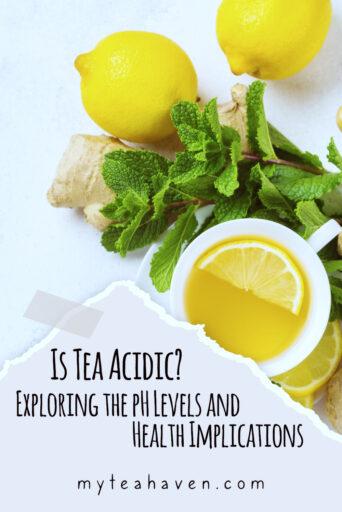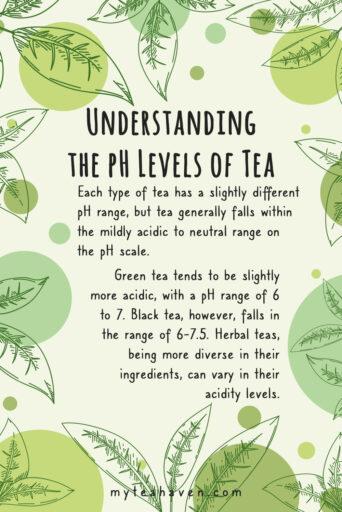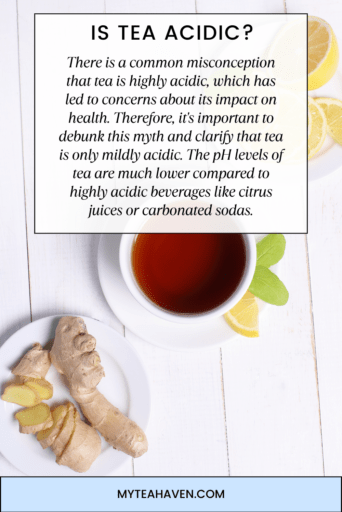Tea Talk: Exploring the Acidity of Your Favorite Brew
Is Tea Acidic?
Here’s a question that you might have asked yourself once or twice: is tea acidic? The answer might not be as straightforward as you think. Today I am going to provide you with a comprehensive understanding of the acidity of tea and the factors that influence its pH levels. Join me on this exploration of tea and acidity, as we unravel the truth behind this intriguing question.
We are a participant in the Amazon Services LLC Associates Program, an affiliate advertising program designed to provide a means for us to earn fees by linking to Amazon.com and related sites. This post may contain affiliate links which means we may receive a commission, at no cost to you, for purchases made using our links. Please see my disclosure to learn more. Unless otherwise stated, all prices are in US$.
What is Acidity and pH Level?
Before delving into the acidity of tea, let’s briefly understand what acidity means. Acidity refers to the presence of acids in a substance, which can be measured on a scale called pH.

The pH scale ranges from 0 to 14, with 7 being neutral, values below 7 indicating acidity, and values above 7 indicating alkalinity.
So, the lower the pH value is then the more acidic the substance in question is.
Now that we have a very basic understanding of acidity and pH, let’s take a look at what kind of role that plays in the world of tea.
Explaining Different Types of Tea
Tea comes in various forms. I’ve talked about the most popular types of tea before, which include green tea, black tea, herbal tea, and oolong tea.
Understanding these different types of tea is crucial in unraveling the acidity puzzle.
Green tea is known for its refreshing and grassy taste.
Black tea undergoes a fermentation process that gives it a robust and bold flavor.
Oolong tea, with its partially fermented leaves, provides a delicate balance of flavors between green and black tea.
Herbal teas offer a wide range of flavors and health benefits.


HANDPICK Chamomile Tea Bags
Indulge in the enchanting flavors of our chamomile teas, where the soothing essence of chamomile meets a delightful floral twist. Our chamomile tea offers a true taste of nature, allowing you to savor the soothing and floral notes that make chamomile a beloved herbal infusion.
Understanding the pH Levels of Tea
Each type of tea has a slightly different pH range, but tea generally falls within the mildly acidic to neutral range on the pH scale.
Green tea tends to be slightly more acidic, with a pH range of 6 to 7. Black tea, however, falls in the range of 6-7.5. Herbal teas, being more diverse in their ingredients, can vary in their acidity levels.
Debunking the Misconception: Is Tea Acidic?
There is a common misconception that tea is highly acidic, which has led to concerns about its impact on health. Therefore, it’s important to debunk this myth and clarify that tea is only mildly acidic. The pH levels of tea are much lower compared to highly acidic beverages like citrus juices or carbonated sodas.
The Impact of Brewing Methods on Tea Acidity

The natural acidity of tea is relatively mild, but the way in which we brew it can have an impact on its acidity levels.
Factors such as steeping time and temperature, as well as the type of water used, can influence the pH of the final brew.
Longer steeping times and higher temperatures tend to extract more tannins from tea leaves, which can contribute to a slightly higher acidity level.
The Effect of Additives on Tea Acidity
Another aspect to consider is the addition of various ingredients to tea. Additives such as lemon or citrus fruits can increase the acidity of tea due to their own acidic properties.
The overall impact on the pH level of the tea may vary based on the quantity of the additive and the type of tea used.
On the other hand, adding milk or cream to tea can help neutralize the acidity, making it a popular choice for those who prefer a milder flavor.
Sugar and sweeteners, though not directly affecting tea acidity, can alter the taste profile.

Health Implications of Tea Acidity
Many people wonder about the health implications of consuming mildly acidic beverages like tea. In terms of dental health, tea’s acidity can potentially contribute to enamel erosion if consumed in excessive amounts or without proper oral hygiene. That being said, it’s worth noting that the impact is relatively minor compared to highly acidic drinks.
Tea’s acidity may affect individuals with certain gastrointestinal conditions. This also largely depends on personal tolerance and sensitivity.
Tips for Reducing Tea Acidity
For those concerned about the acidity of tea, several strategies can be employed to mitigate its effects.

Choosing low-acid teas, such as certain herbal blends, can be an excellent option. Adjusting brewing methods, such as reducing steeping time and using slightly cooler water, can also help reduce tea acidity.
Furthermore, adding alkaline additives like a tiny pinch of baking soda can help neutralize the acidity without significantly altering the taste.
The Importance of Personal Preference
When it comes to tea and its acidity, personal preference and health requirements ultimately play the most important roles in determining whether a tea variety is too acidic for you or not.
Some individuals may enjoy the slight tanginess of mildly acidic tea, while others may prefer a milder taste. It’s essential to experiment with different teas, brewing methods, and additives to find the perfect balance that best suit your desires.
A Few Final Thoughts
While tea is mildly acidic, it is not highly acidic as commonly believed.
The pH levels of different teas may vary slightly, but they generally fall within the mildly acidic to neutral range.

Brewing methods, additives, and personal preferences can all influence the perceived acidity of tea. By understanding these factors and making informed choices, tea lovers around the world can enjoy their favorite beverage without undue concern about its acidity.
Some Questions You Might Have
- Is tea more acidic than coffee?
While both tea and coffee are mildly acidic, coffee tends to have a lower pH level than most teas.
- Does the type of tea bag affect tea acidity?
The type of tea bag used, such as paper or nylon, does not significantly affect the acidity of the brewed tea. The primary factors influencing tea acidity are the tea leaves themselves and the brewing process.
- Can I reduce tea acidity by adding more water?
Diluting tea with more water can help reduce its perceived acidity. But remember that the tea’s flavor might become compromised if you add too much water.
- Does decaffeinated tea have lower acidity?
Decaffeinated tea generally has a slightly lower acidity compared to regular tea. That being said, the difference in acidity between decaffeinated and regular tea is usually minimal and may not be noticeable to most individuals.
- Are herbal teas less acidic than regular teas?
Herbal teas can vary in their acidity levels depending on the ingredients used. While some herbal teas may be less acidic than certain Camellia sinensis teas, others may have similar or even higher acidity levels. It’s best to check the specific herbal tea you’re interested in.








Comments are closed.